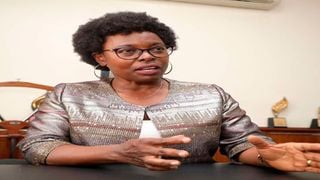
Controller of Budget Margaret Nyakang’o.
| Jeff Angote | Nation Media GroupCounties
Premium
Shame of 22 counties sitting on development funds
What you need to know:
- Development projects were allocated a measly Sh3.5 billion, which was not utilised.
- Failure to spend the money could mean the counties did not have approved budgets.
About half of the counties did not utilise their development funds in the first quarter of this financial year, dealing a blow to critical sectors of health, water and infrastructure.
In her latest report for the period between July and September 2021, Controller of Budget Margaret Nyakang’o says 22 counties spent Sh49.28 billion, or 93.3 per cent of their total expenditure on recurrent activities, including payment of salaries and allowances.
Development projects were allocated a measly Sh3.5 billion, which was not utilised. Economic growth is largely dependent on how much investment is made in key areas, such as infrastructure and health.
Failure to spend the money could mean the counties did not have approved budgets and therefore did not have authority to spend it.
Counties that spent nothing on development activities are Baringo, Bungoma, Busia, Homa Bay, Isiolo, Kajiado, Kericho, Kilifi and Kisumu. Others are Machakos, Marsabit, Migori, Mombasa, Nairobi City, Nakuru, Narok, Nyandarua, Siaya, Taita-Taveta, Trans Nzoia, Vihiga and Wajir.
“Counties incurred Sh3.55 billion representing an absorption rate of 1.9 per cent instead of the expected 7.5 per cent of their annual development expenditure budget of Sh.185.28 billion. This indicates counties did not prioritise the implementation of development projects during the period.
Pending bills
“CoB recommends that counties prioritize implementing development projects to improve the standard of living for their citizens. Further, County governments should ensure that expenditure on development activities meets the minimum set ceiling of 30 per cent of their budgets,” Dr Nyakang’o states in her report.
Some 30 counties did not report any payments towards the settlement of pending bills at the beginning of the financial year. They are Baringo, Bungoma, Busia, Elgeyo-Marakwet, Homa Bay, Isiolo, Kajiado, Kilifi, Kisumu, Kwale, Lamu, Machakos, Marsabit, Meru, Migori, Nairobi City and Nakuru.
Others are Nandi, Narok, Nyamira, Nyandarua, Samburu, Tana River, Tharaka Nithi, Trans Nzoia, Turkana, Uasin Gishu, Vihiga, Wajir and West Pokot.
“Failure to make payments when due constitutes a severe material breach of public finance principles as provided under Article 201 of the Constitution and violates the Public Finance Management Act, 2012,” warns Dr Nyakang’o.
The report also highlights less collection of own source revenue. During the reporting period, Sh6.76 billion, which was 12 per cent of the annual target of Sh56.52 billion, was generated by the 47 devolved units against an expected performance of 25 per cent of the annual target.
Annual targets
That under-performance implies that some planned activities may not be implemented during the financial year as budgets will not be fully financed. The report recommended that counties should revise down their targets and resist over-optimism.
Counties are expected to collect at least 25 per cent of their annual targets in any quarter to stand a chance of attaining the revenue targets.
Most counties have since integrated electronic payment mechanisms and systems aimed at expanding their revenue base and increasing tax compliance but still fail to hit initial targets.
Proponents of the e-payment platforms say they have either eliminated or reduced corruption and leakages by allowing customers to pay bills without visiting county offices.
But lack of adequate infrastructure in far-flung counties have barred authorities and citizens from exploiting the full potential of ICT in optimising revenue collection.
Relying on one major own-source revenue has exposed counties to fiscal shocks occasioned by a dip in their main revenue source, inevitably generating pending bills and causing general cash flow problems.





